HIP TO
CROCHET

23
Contemporary
Projects
for Todays Crocheter

Judith L. Swartz

Acknowledgments I am very grateful to have had the privilege and challenge of writing this book. However, it would not have materialized without the help of many people. My sincere thanks go out to all who participated. First, to my friend and editor Marilyn Murphy; Once again your vision and hard work have kept me going forward. Your capabilities continue to inspire me, and I treasure being able to work with you again. To Jean Lampe, my technical editor; I am convinced that you have the patience of a saint, the eyes of an eagle, and the mind of a mathematician. I am so grateful that I have been lucky enough again to have the support of your expertise.  Thanks to the entire staff at Interweave Press, a talented group of people who have each added their hard work and personal touches to give this book its incredible look.
Thanks to the entire staff at Interweave Press, a talented group of people who have each added their hard work and personal touches to give this book its incredible look.  Thank you to all the companies who supplied the beautiful yarns for the projects in this book. It is always a pleasure to work with fine materials.
Thank you to all the companies who supplied the beautiful yarns for the projects in this book. It is always a pleasure to work with fine materials.  Thanks to my crocheters Lynn Gates and Birgitta Stolpe. I am very grateful for your quick and careful work and your willingness to take on the task.
Thanks to my crocheters Lynn Gates and Birgitta Stolpe. I am very grateful for your quick and careful work and your willingness to take on the task.  Thank you also to my dear friend Lynn Horwitz Coe for your design consulting expertise as well as your enthusiasm and your belief in me. I must also acknowledge my college crochet teacher, Renie Breskin Adams, who first taught me the versatility and beauty of crochet.
Thank you also to my dear friend Lynn Horwitz Coe for your design consulting expertise as well as your enthusiasm and your belief in me. I must also acknowledge my college crochet teacher, Renie Breskin Adams, who first taught me the versatility and beauty of crochet.  I would also like to acknowledge my family. I am very grateful to my wonderful husband, Joel Marcus, for his support, encouragement, love, and patience, and for giving me the time I needed to complete this project.
I would also like to acknowledge my family. I am very grateful to my wonderful husband, Joel Marcus, for his support, encouragement, love, and patience, and for giving me the time I needed to complete this project.  Thank you to my sister Susan Fish for her love and support. Thank you to my parents, Claire and Alex Swartz; though no longer with us, they continue to inspire me. Last of all, I must mention my cat and dog, Charlotte and Tova, who stayed on my lap or by my side, providing their own special style of love and support through many hours of crochet.
Thank you to my sister Susan Fish for her love and support. Thank you to my parents, Claire and Alex Swartz; though no longer with us, they continue to inspire me. Last of all, I must mention my cat and dog, Charlotte and Tova, who stayed on my lap or by my side, providing their own special style of love and support through many hours of crochet.

Table of Contents

Cozy Bohemian Coat Sweater on
Techniques and Tips
Introduction As a fiber major attending college in the 1970s, concentrating on nonloom construction techniques, I found that crochet became a natural form of artistic expression. Ever since those undergrad days, I have valued crochet as a marvelous means of creativity.  I value crochet with good reason: It is a very simple technique that is capable of producing very sophisticated results. You need only one simple tool and yarn, and you can easily learn the components because one stitch builds upon the next in complexity. Crochet is astoundingly versatileyou can create the finest of gossamer heirloom lace as successfully as a sturdy jute rug. Given these facts, and considering the vast potential of the technique, you might think that crochet would have an even more devoted following than it already does.
I value crochet with good reason: It is a very simple technique that is capable of producing very sophisticated results. You need only one simple tool and yarn, and you can easily learn the components because one stitch builds upon the next in complexity. Crochet is astoundingly versatileyou can create the finest of gossamer heirloom lace as successfully as a sturdy jute rug. Given these facts, and considering the vast potential of the technique, you might think that crochet would have an even more devoted following than it already does.  For some people, however, the word crochet brings to mind only images of doilies, granny squares, and lumpy sweaters, so they dismiss the technique without ever realizing its beauty. Doilies are charming, even purposefulbut they may well be anachronistic in the twenty-first century. Granny squares were probably invented out of the necessity to use small scraps of yarn, much like patchwork quilts; while they will always serve a purpose, they may still be recovering from overexposure in the 1960s and 1970s. As for crocheted sweaters, they neednt be lumpy. Refined and carefully worked, these sleek new sweaters debunk the fussy, old myth.
For some people, however, the word crochet brings to mind only images of doilies, granny squares, and lumpy sweaters, so they dismiss the technique without ever realizing its beauty. Doilies are charming, even purposefulbut they may well be anachronistic in the twenty-first century. Granny squares were probably invented out of the necessity to use small scraps of yarn, much like patchwork quilts; while they will always serve a purpose, they may still be recovering from overexposure in the 1960s and 1970s. As for crocheted sweaters, they neednt be lumpy. Refined and carefully worked, these sleek new sweaters debunk the fussy, old myth.  With crochets recent surge in popularity, an enthusiastic new generation is eagerly exploring its great potential. In writing this book, I wanted to create designs that represent the crochet of today; however, Ive allowed the crocheters fondness for vintage patterns to help shape designs that are contemporary, yet classic. Todays crocheters easily can construct (but arent limited to) the projects in Hip to Crochet, and while some projects may have roots in the past, they all have a very viable, fun, and fresh purpose in the present.
With crochets recent surge in popularity, an enthusiastic new generation is eagerly exploring its great potential. In writing this book, I wanted to create designs that represent the crochet of today; however, Ive allowed the crocheters fondness for vintage patterns to help shape designs that are contemporary, yet classic. Todays crocheters easily can construct (but arent limited to) the projects in Hip to Crochet, and while some projects may have roots in the past, they all have a very viable, fun, and fresh purpose in the present.  Youll find the patterns, in user-friendly formats, easy to read. Sidebar lessons provide further information and help demystify details. All in all, I hope that this book will inspire the next generation of crochet enthusiasts with a new-millenium approach and a positive learning experience.
Youll find the patterns, in user-friendly formats, easy to read. Sidebar lessons provide further information and help demystify details. All in all, I hope that this book will inspire the next generation of crochet enthusiasts with a new-millenium approach and a positive learning experience.

Holding the Hook
There are two ways of holding the crochet hookpencil style (). Try them both to see which way is most comfortable for you.
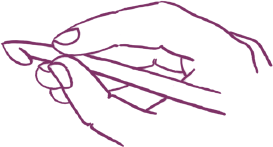
Figure 1
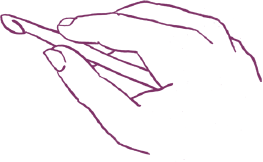
Figure 2
Slipknot
A foundation chain begins with a slipknot. Starting about four to six inches from the end of the yarn, make a loop (). Dont pull the end too tightly or you wont be able to work into this stitch.
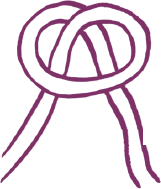
Figure 1

Figure 2
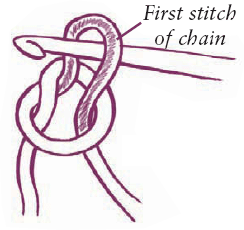
Figure 3
Chain Stitch
The first row of any crochet patternoften called the foundation chain or rowis worked into a chain stitch. Holding the yarn as shown (). Each loop counts as a stitch. If the pattern instructs you to chain 10 stitches, you will chain 10 plus the number for the turning chain.



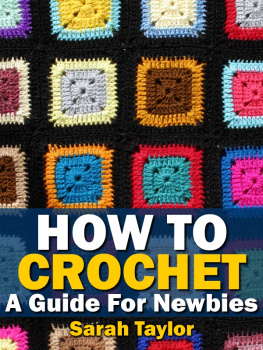
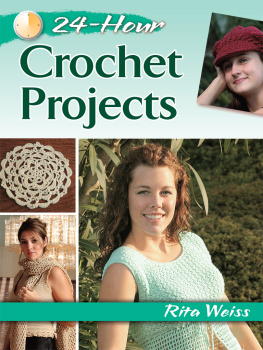
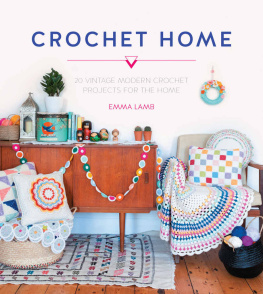

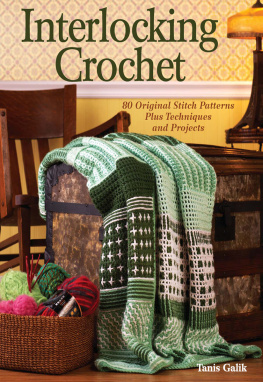


 Thanks to the entire staff at Interweave Press, a talented group of people who have each added their hard work and personal touches to give this book its incredible look.
Thanks to the entire staff at Interweave Press, a talented group of people who have each added their hard work and personal touches to give this book its incredible look.  Table of Contents
Table of Contents
 I value crochet with good reason: It is a very simple technique that is capable of producing very sophisticated results. You need only one simple tool and yarn, and you can easily learn the components because one stitch builds upon the next in complexity. Crochet is astoundingly versatileyou can create the finest of gossamer heirloom lace as successfully as a sturdy jute rug. Given these facts, and considering the vast potential of the technique, you might think that crochet would have an even more devoted following than it already does.
I value crochet with good reason: It is a very simple technique that is capable of producing very sophisticated results. You need only one simple tool and yarn, and you can easily learn the components because one stitch builds upon the next in complexity. Crochet is astoundingly versatileyou can create the finest of gossamer heirloom lace as successfully as a sturdy jute rug. Given these facts, and considering the vast potential of the technique, you might think that crochet would have an even more devoted following than it already does. 





